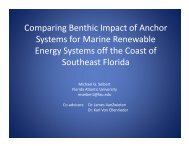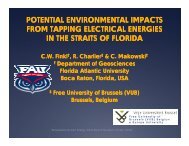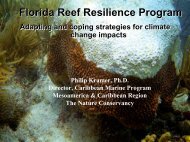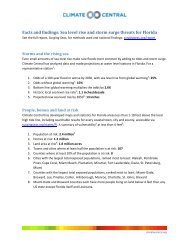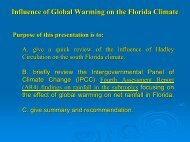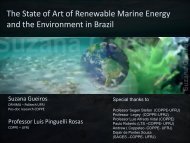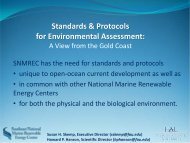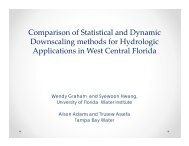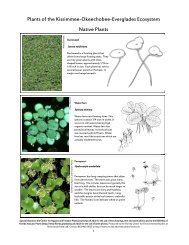Executive Summary - Florida Center for Environmental Studies - Fau ...
Executive Summary - Florida Center for Environmental Studies - Fau ...
Executive Summary - Florida Center for Environmental Studies - Fau ...
Create successful ePaper yourself
Turn your PDF publications into a flip-book with our unique Google optimized e-Paper software.
BACKGROUND<br />
The <strong>Center</strong> <strong>for</strong> <strong>Environmental</strong> <strong>Studies</strong> (CES) at <strong>Florida</strong><br />
Atlantic University (FAU) and the U.S. Geological Survey<br />
(USGS) held a workshop on March 29-30, 2012 at<br />
FAU in Davie, <strong>Florida</strong>. The purpose of this workshop<br />
was twofold:<br />
• Assess the state of knowledge of the impacts of<br />
current and future climate change on the hydrological<br />
cycle in the Everglades including gaining a<br />
greater understanding of downscaled hydrologic<br />
global models <strong>for</strong> the Everglades.<br />
• Examine each of the components of the cycle in<br />
the greater Everglades by identifying:<br />
• our understanding of potential changes in precipitation<br />
quantity and intensity, evapotranspiration,<br />
percolation to groundwater, runoff<br />
and drainage, and<br />
• critical knowledge gaps with respect to future<br />
patterns and their impact.<br />
The plenary sessions opened with a series of presentations<br />
that set the stage by providing a common basis<br />
of in<strong>for</strong>mation <strong>for</strong> the discussion groups to draw<br />
upon. The first group of speakers provided a “Big Picture<br />
Perspective” on the climate change implications<br />
<strong>for</strong> <strong>Florida</strong>, including the state of knowledge, downscaling<br />
global models and changes in hydrology. This<br />
was followed by a review of selected components of<br />
the hydrological cycle, including precipitation, temperature,<br />
evapotranspiration and groundwater and<br />
surface water flows. More importantly the idea of<br />
this workshop was to focus on the impact of global<br />
climate change on rainfall variability and hydrologic<br />
variations, and their consequent implications on Everglades<br />
restoration and water management in South<br />
<strong>Florida</strong> in the near term (10-30 years) and long term<br />
(end of century).<br />
DOWNSCALING ISSUES<br />
A series of discussions on the complexity of downscaling<br />
from global models to this peninsular region<br />
revealed significant problems with projections of<br />
future precipitation patterns but better predictions<br />
of temperature change. Decadal variations involving<br />
El Niño and the Southern Oscillation complicate<br />
the picture. Urbanization and change in land use<br />
are also important.<br />
THE HYDROLOGIC CYLCLE<br />
Research indicates that the hydrologic cycle will<br />
change in the future and water management<br />
must be modified to handle these changes. Current<br />
temperature projections show a rise of 1-2°C<br />
(1.8-3.6°F), precipitation change may be ±10% and<br />
evapotranspiration (ET) may increase 3-6 inches by<br />
2050. North <strong>Florida</strong> will be warmer and South <strong>Florida</strong>,<br />
at the same latitude as the Sahara, will be drier.<br />
Precipitation is the main driver of Everglades<br />
hydrology. The research priorities are:<br />
• Understanding trends in extreme precipitation<br />
events, like tropically-driven heavy rainfall systems<br />
and droughts.<br />
• Developing knowledge with spatial and temporal<br />
trends of precipitation.<br />
• Understanding how spatial and temporal trends<br />
have changed throughout history and how they<br />
will evolve with a changing climate.<br />
• Examining the relationship between precipitation<br />
trends of urban and natural systems.<br />
• Developing models that incorporate future land<br />
use changes.<br />
• Identifying current and future urban heat islands<br />
and the local effects they may induce on<br />
regional precipitation trends.





